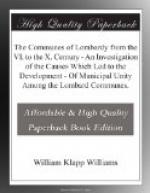It is doubtful whether immunities of any importance were granted even by the latest kings of the Lombards, before the invasion of the Franks. Under the first Lombard monarchy the church held a very subordinate position with regard to the state, and if privileges were granted to any of its members, they had attached to them no greater meaning than the simple extension to them of the mundibrium of the king, such as was often allowed to private individuals; that is, they were simply grants of royal protection, and were not similar to the later grants which included both protection and privilege.[89]
With the advent of Frankish rule under Charlemagne, marked consideration immediately appears for the church and its representatives. Not alone is ample protection granted to many of the churches of the kingdom, but to it is added the important function of exemption. The greatest evil endured in those days by the ecclesiastical authorities was exactions levied on their property and oppression exercised on their dependents by the dukes and counts under whose jurisdiction lay the temporal possessions of the churches and monasteries. Consequently the aim of every bishop and of every abbot was to obtain for the possessions of his diocese or his convent an exemption more or less complete from the civil administration of the neighboring secular ruler. For a long time there was no thought in the mind of the bishop of gaining for himself the functions of temporal jurisdiction, but simply that the power of the count should be restrained with regard to church property, that is, that he should not be able to exercise his judicial control over lands belonging to the church, except by the express permission, “per licentia data,” and with the concurrence of the bishop himself. This and nothing more is what is meant by all of the charters of exemption granted by the Carlovingian rulers, down to the time of Charles the Bald, when, as we shall presently see, a change was introduced.
It would be useless for me to cite examples of such charters, for their number is countless, and reference may be made to any of the great collections of mediaeval documents for confirmation of what has just been said; for during the reigns of the earlier Carlovingians, the strong reverence for the church and respect for its officers which characterized the Frankish nation from the beginning led to the extension of these privileges to much the greater number of the churches in the realm. Not all churches enjoyed such grants, and




